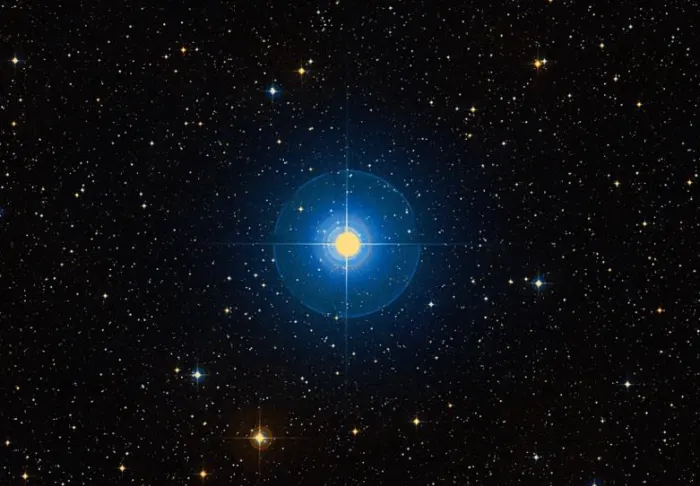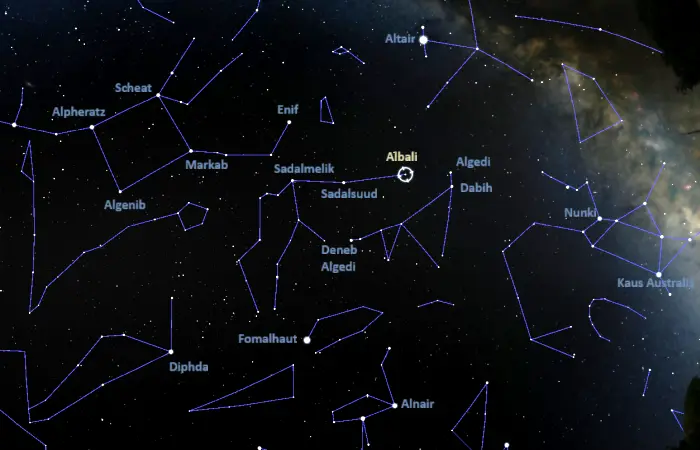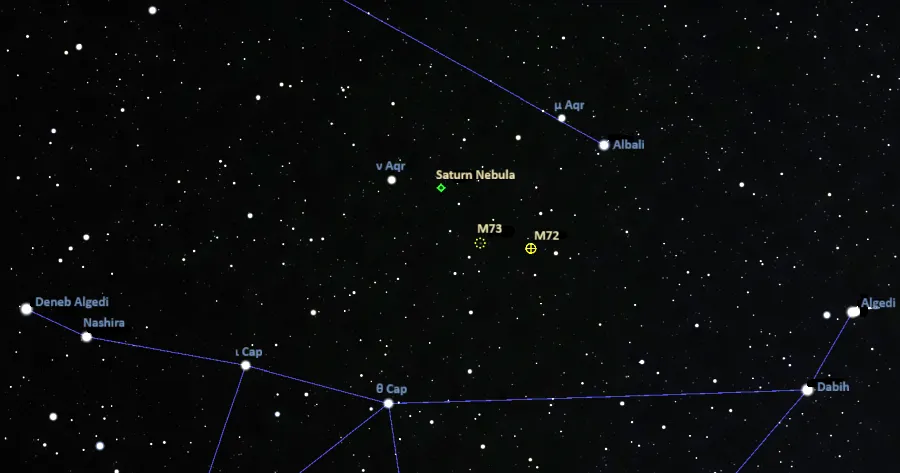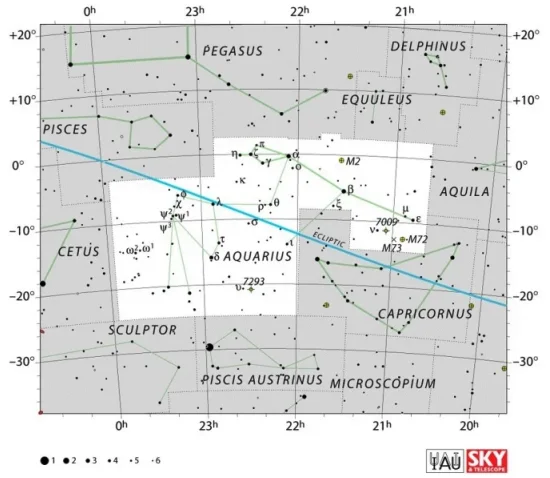Albali, Epsilon Aquarii (ε Aqr), is a binary star located approximately 244 light-years away in the constellation Aquarius. With an apparent magnitude of 3.77, it is the seventh brightest star in the constellation. It can be used to find the famous Saturn Nebula (NGC 7009), the globular cluster Messier 72, and the asterism Messier 73.
Star system
Epsilon Aquarii is a spectroscopic binary star system composed of two main sequence stars of spectral types A1 V and KV. The two components orbit each other with a period of 1.2 years from a distance of 1.7 astronomical units (AU). They are separated by 25.9 milliarcseconds in the sky and cannot be resolved, even in larger telescopes.
Epsilon Aquarii A, formally known as Albali, presents as a main sequence star with the spectral class A1 V. It has a mass 2.98 times that of the Sun and a radius 4.2 times the Sun’s. With an effective temperature of 9,622 K, it is around 161 times more luminous than the Sun.
Albali is much younger than the Sun. It has an estimated age of 388 million years. Like many other A-type stars, it is a fast spinner. It has a projected rotational velocity of 118 km/s. The star is moving towards Earth with a radial velocity of -20 km/s.
The binary nature of Epsilon Aquarii was unknown until very recently. The companion to Albali was discovered based on interferometric observations with the GRAVITY instrument on the Very Large Telescope Interferometer (VLTI) in 2023. The discovery was reported by a team of astronomers led by Idel Waisberg.
Based on isochrone fitting, the astronomers proposed that the primary component has recently become a subgiant star. After exhausting the supply of hydrogen in its core, it evolved away from the main sequence and is gradually moving to higher luminosities.
The secondary component, Epsilon Aquarii B, is an orange main sequence star with a mass of 0.6 solar masses and a radius of 0.57 solar radii. It has an estimated surface temperature of 4,070 K.

Albali (Epsilon Aquarii), image credit: ESO/Digitized Sky Survey 2 (CC BY 4.0)
Name
The name Albali (pronunciation: /ælˈbeɪli/) comes from the Arabic albāli‘, meaning “the swallower.” In Arabic astronomy, Epsilon Aquarii, Mu Aquarii and Nu Aquarii formed the lunar mansion known as al Bulaʽ, “the Swallower.” Mu and Nu Aquarii shared the traditional name Albulaan, derived from al-bulaʽān, meaning “the two swallowers.”
The origin of the names is unknown. The 13th Persian astronomer Al Kazwini offered a vague explanation, noting that the name comes from the two stars being more “open” than the nearby Algedi (Alpha2 Capricorni) and Dabih (Beta Capricorni) and that they seemed to absorb, or swallow, the light of the other.
The International Astronomical Union’s (IAU) Working Group on Star Names (WGSN) approved the name Albali for Epsilon Aquarii on September 12, 2016.
Epsilon Aquarii was called Nir Saad Bula (nayyir sa’d al bulaʽ) in the 17th century Egyptian astronomer Al Achsasi al Mouakket’s Calendarium. The name was later translated into Latin as Lucida Fortunæ Dissipantis (“the brightest luck of the swallower”).
In traditional Chinese astronomy, Albali was known as 女宿一 (Nǚ Sù yī), the First Star of Girl. It formed the Girl asterism with Mu Aquarii, 4 Aquarii, and 3 Aquarii. The asterism was part of the larger Girl mansion, one of the northern mansions of the Black Tortoise.
Location
Albali is not difficult to find, but it can be a challenging target to observe from areas with too much light pollution. It is the brightest point of light between Sadalsuud, the brightest star in Aquarius, and Algedi in Capricornus.
Sadalsuud can be found by extending a line through the Great Square of Pegasus, and Algedi appears close to the line extended through the Shaft of Aquila, formed by the bright Altair and two stars flanking it. Sadalsuud is part of a zig-zag pattern known as the Lightning Bolt, also formed by Enif in Pegasus, Sadalmelik in Aquarius, and Deneb Algedi in Capricornus.
Albali can be used to find the bright Saturn Nebula (NGC 7009), the globular cluster Messier 72, and the asterism Messier 73. The Saturn Nebula appears east of the star, near Nu Aquarii. With an apparent magnitude of 8.0, it is one of the brightest planetary nebulae in the sky.
The star cluster Messier 72 appears 3 degrees south and 1.5 degrees east of the star, and the asterism M73 lies 1.5 degrees east of M72. All three objects can be observed in binoculars and small telescopes.

Location of Albali (Epsilon Aquarii), image: Stellarium

Albali, the Saturn Nebula, Messier 72 and Messier 73, image: Stellarium
Constellation
Albali is located in the constellation Aquarius. It appears in the left hand of the celestial Water Bearer.
Aquarius is one of the zodiac constellations, located on the ecliptic (the Sun’s apparent path across the sky). It was catalogued by Claudius Ptolemy of Alexandria along with other ancient constellations in the 2nd century CE.
Aquarius is the 10th largest of the 88 constellations. It stretches across 980 square degrees of the predominantly southern sky. It is one of the 15 equatorial constellations, visible from virtually anywhere for at least part of the year.
Aquarius does not stand out in the night sky. Its brightest stars, the yellow supergiants Sadalsuud and Sadalmelik, are third magnitude stars. They form an asterism called the Lightning Bolt with Enif in Pegasus and Deneb Algedi in Capricornus.
Sadalsuud (Beta Aquarii), the brightest star in Aquarius, shines at magnitude 2.87 from a distance of 542 light years, while Sadalmelik (Alpha Aquarii) has a visual magnitude of 2.942 and lies 691.1 light-years away.
Other notable stars in the constellation include the massive A-type main sequence star Skat (Delta Aquarii), the triple star Zeta Aquarii, the orange giant Safina (88 Aquarii), the variable red giant Shatabhisha (Lambda Aquarii), the binary star Sadachbia (Gamma Aquarii), the yellow giants Ancha (Theta Aquarii) and Nu Aquarii, the symbiotic star R Aquarii, the old and ultra-metal-poor Sneden’s Star (BPS CS22892-0052), and the nearby triple star system EZ Aquarii.

Aquarius constellation map by IAU and Sky&Telescope magazine (Roger Sinnott & Rick Fienberg) (CC BY 3.0)
Aquarius hosts several stars with confirmed planetary systems. The best-known of these is the red dwarf TRAPPIST-1 with seven orbiting planets. Others include the orange dwarf HD 215152, the red dwarf Gliese 876, and the yellow dwarf WASP-47, with four planets each.
Notable deep sky objects in Aquarius include the globular clusters Messier 2 and Messier 72, the bright planetary nebulae NGC 7392 (the Helix Nebula) and NGC 7009 (the Saturn Nebula), and the peculiar galaxies NGC 7727 and NGC 7252 (the Atoms for Peace Galaxy).
The best time of the year to see the stars and deep sky objects in Aquarius is during the month of October, when the constellation rises higher above the horizon in the early evening. The entire constellation can be seen from locations between the latitudes 65° N and 90° S.
The 10 brightest stars in Aquarius are Sadalsuud (Beta Aqr, mag. 2.87), Sadalmelik (Alpha Aqr, mag. 2.942), Skat (Delta Aqr, mag. 3.28), Zeta Aquarii (mag. 3.65), Safina (88 Aqr, mag. 3.679), Shatabhisha (Lambda Aqr, mag. 3.722), Albali (Epsilon Aqr, mag. 3.77), Sadachbia (Gamma Aqr, mag. 3.849), 98 Aquarii (mag. 3.97), and Eta Aquarii (mag. 4.04).
Albali – Epsilon Aquarii
| Spectral class | A1 V + KV |
| U-B colour index | +0.029 |
| B-V colour index | −0.001 |
| Apparent magnitude | 3.77 |
| Absolute magnitude | −0.46 |
| Distance | 244 ± 7 light years (75 ± 2 parsecs) |
| Parallax | 13.3619 ± 0.3737 mas |
| Radial velocity | −19.82 ± 0.58 km/s |
| Proper motion | RA: +33.923 ± 0.429 mas/yr |
| Dec.: −34.926 ± 0.286 mas/yr | |
| Constellation | Aquarius |
| Right ascension | 20h 47m 40.5495728200s |
| Declination | −09° 29′ 44.796936843″ |
| Names and designations | Albali, Epsilon Aquarii, Epsilon Aqr, ε Aquarii, ε Aqr, 2 Aquarii, 2 Aqr, HD 198001, HR 7950, HIP 102618, SAO 14481, BD−10°5506, FK5 781, PLX 4960.00, PPM 204453, SKY# 39419, GC 28978, GCRV 13033, GEN# +1.00198001, GSC 05760-01997, JP11 3276, SACS 455, ROT 3036, IRAS 20449-0940, 2MASS J20474055-0929447, N30 4597, PMC 90-93 550, TD1 27255, TIC 51750453, TYC 5760-1997-1, UBV 17998, UBV M 25159, uvby98 100198001, WEB 18594, YZ 99 7360, Gaia DR2 6903096911031159424, Gaia DR3 6903096911032851584 |
Epsilon Aquarii A
| Mass | 2.98 ± 0.03 M☉ |
| Luminosity | 161 ± 9 L☉ |
| Radius | 4.2 R☉ |
| Temperature | 9,622 ± 327 K |
| Metallicity | −0.08 ± 0.35 dex |
| Age | 388 million years |
| Rotational velocity | 118.0 ± 5.9 km/s |
| Surface gravity | 3.66 ± 0.14 cgs |
Epsilon Aquarii B
| Mass | 0.61 M☉ |
| Radius | 0.57 R☉ |
| Temperature | 4,070 K |